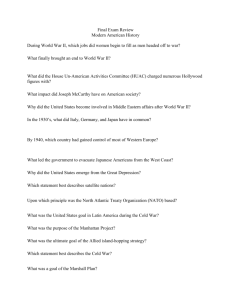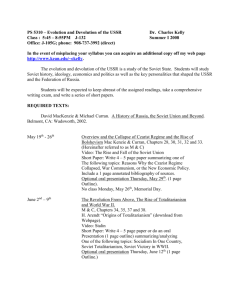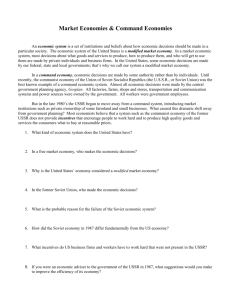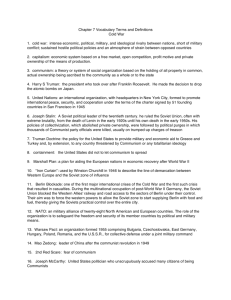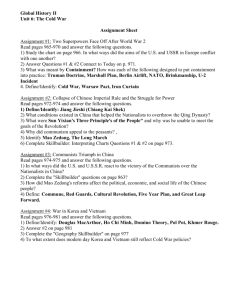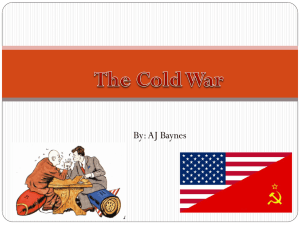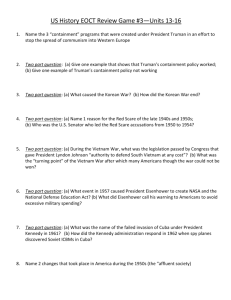The Cold War as Context - Society for History in the Federal
advertisement
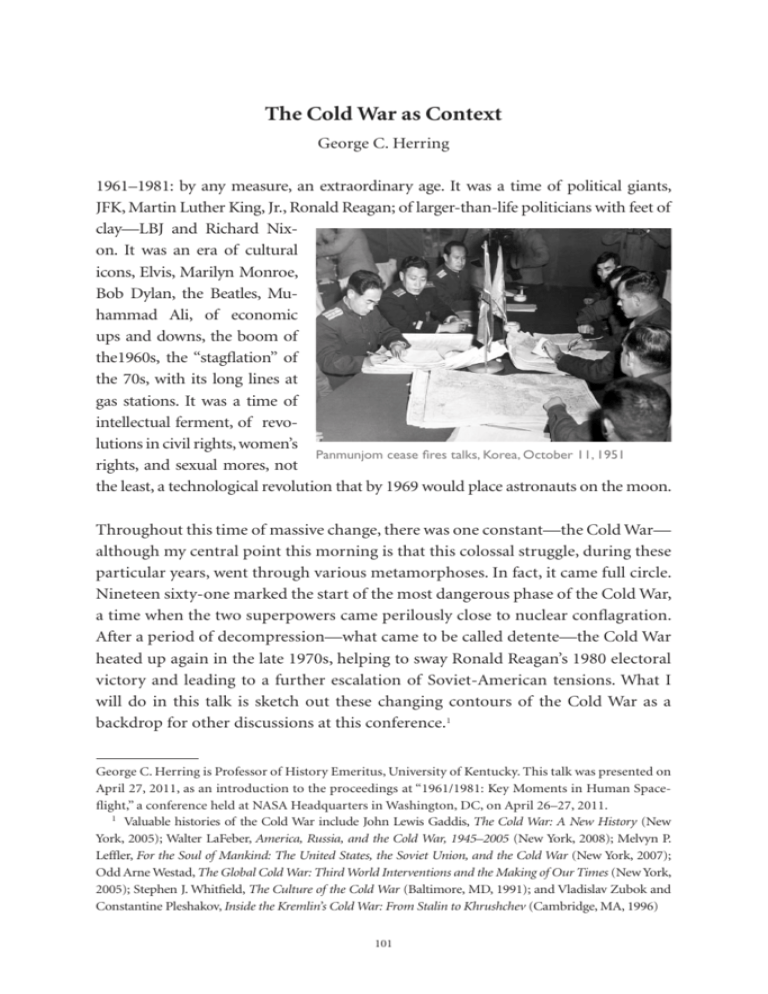
The Cold War as Context George C. Herring 1961–1981: by any measure, an extraordinary age. It was a time of political giants, JFK, Martin Luther King, Jr., Ronald Reagan; of larger-than-life politicians with feet of clay—LBJ and Richard Nixon. It was an era of cultural icons, Elvis, Marilyn Monroe, Bob Dylan, the Beatles, Muhammad Ali, of economic ups and downs, the boom of the1960s, the “stagflation” of the 70s, with its long lines at gas stations. It was a time of intellectual ferment, of revolutions in civil rights, women’s Panmunjom cease fires talks, Korea, October 11, 1951 rights, and sexual mores, not the least, a technological revolution that by 1969 would place astronauts on the moon. Throughout this time of massive change, there was one constant—the Cold War— although my central point this morning is that this colossal struggle, during these particular years, went through various metamorphoses. In fact, it came full circle. Nineteen sixty-one marked the start of the most dangerous phase of the Cold War, a time when the two superpowers came perilously close to nuclear conflagration. After a period of decompression—what came to be called detente—the Cold War heated up again in the late 1970s, helping to sway Ronald Reagan’s 1980 electoral victory and leading to a further escalation of Soviet-American tensions. What I will do in this talk is sketch out these changing contours of the Cold War as a backdrop for other discussions at this conference.1 George C. Herring is Professor of History Emeritus, University of Kentucky. This talk was presented on April 27, 2011, as an introduction to the proceedings at “1961/1981: Key Moments in Human Spaceflight,” a conference held at NASA Headquarters in Washington, DC, on April 26–27, 2011. 1 Valuable histories of the Cold War include John Lewis Gaddis, The Cold War: A New History (New York, 2005); Walter LaFeber, America, Russia, and the Cold War, 1945–2005 (New York, 2008); Melvyn P. Leffler, For the Soul of Mankind: The United States, the Soviet Union, and the Cold War (New York, 2007); Odd Arne Westad, The Global Cold War: Third World Interventions and the Making of Our Times (New York, 2005); Stephen J. Whitfield, The Culture of the Cold War (Baltimore, MD, 1991); and Vladislav Zubok and Constantine Pleshakov, Inside the Kremlin’s Cold War: From Stalin to Khrushchev (Cambridge, MA, 1996) 101 102 | Federal History 2012 The phrase Cold War was coined by journalist Walter Lippmann in 1946 to describe the emerging conflict between the United States and the Soviet Union and the condition of neither war nor peace that followed World War II. That conflict resembled traditional power struggles among nation states. It was also an ideological clash, in which each nation denied the other’s right to exist. But it was unique in that the major combatants, each in time possessing enormously destructive nuclear weapons and increasingly sophisticated delivery systems, waged it largely through client states and by diplomatic means, propaganda, and threats of force, rather than by actually fighting each other. The Cold War emerged from a massive realignment of power wrought by World War II. The USSR and the U.S. came out of that conflict the only nations capable of wielding significant influence beyond their borders (although the United States, throughout, was far the stronger of the two). Technology also dramatically—and frighteningly—altered the postwar international system. Stunning innovations in aviation brought the world closer together—and made it more threatening. And what one U.S. official called “the most terrible weapon ever known in human history” —the atomic bomb—was an enormously destabilizing element in the early Cold War years. The new great powers brought to this unstable world long-standing and profound suspicions of each other. Each demonized the other and mythologized its own virtues. Caught in a new and volatile environment, they sought security in ways that reinforced mutual suspicions and intensified conflict. By the 1950s, the Cold War was a central fact of international life, deeply entrenched in both countries. Europe, the first battleground, was divided into hostile blocs—a crude stalemate made volatile by a divided Germany and especially Berlin. In East Asia, the United States and South Korea fought a bloody standoff with Communist China and North Korea. The Cold War became globalized and militarized. Both sides came to view it as a zero sum game in which any apparent gain for one was seen as a loss for the other. Events that might once have seemed unimportant took on great significance. Places of little intrinsic consequence became major Cold War battlegrounds. Deadlocked in Europe and Asia, the combatants in the 1950s shifted their competition to the so-called Third World, the scores of new nations emerging from colonial rule to independence. The Cold War became in the minds of each combatant a “struggle for the soul of mankind” whose outcome would shape the course of world history. Soviet-American competition extended to all phases of human activity: economic productivity, sports, culture. The Cold War as Context | 103 In the United States, a Cold War culture, based on fear, took firm hold. Americans assumed as an article of faith that a monolithic world communist movement led by Moscow sought global domination and would do anything to achieve its goal. Fearing aggression abroad and subversion at home, they saw threats everywhere. One U.S. official warned ominously that communists could be found in “factories, offices, butcher shops, on street corners, in private businesses . . . undermining your Government, plotting to destroy the liberties of every citizen, and feverishly trying . . . to aid the Soviet Union.” Exceptional measures were taken to combat this threat: loyalty oaths, witch hunts, black lists, the firing of suspected subversives. Popular culture undergirded the Red Hysteria. Hollywood spewed out fearmongering films such as I Married a Communist and The Red Menace. Newspapers churned out lurid headlines like “The Reds are After Your Child.” Fear encouraged conformity. Questioning the conventional wisdom was verboten, even among traditionally skeptical college students. (My generation was known as the “Silent Generation”). Cracks in the consensus appeared late in the decade, but it held sway into the 60s, and its influence lingered beyond. II. Confrontation and Crisis, I In the late 1950s, America’s confidence was severely shaken. Under the ebullient and erratic Nikita Khrushchev, the USSR appeared to gain the initiative in the Cold War; the U.S. seemed to be falling behind. In part, to be sure, this resulted from domestic politics. Beginning in 1952, the out-party ritualistically exploited the in-party’s alleged Cold War failures for political gain. But it also reflected perceptions. Because the United States was so closely identified with the European colonial powers, the USSR appeared to be doing better in the Third World. Especially alarming was Fidel Castro’s revolution in nearby Cuba and his gravitation toward Moscow. Still more frightening was a rising fear that the Soviets were outpacing the United States in technology and might secure a crucial military advantage. The alarm bell here was the Soviet launching in October 1957 of the first earth satellite, Sputnik. Viewed as nothing less than a new Pearl Harbor, this stunning feat sent shock waves across the United States. The impact was reinforced by subsequent, very public, and highly embarrassing U.S. launch failures that brought forth many bad jokes. U.S. rockets were labeled “flopniks” and “staputniks.” They were compared to civil servants, of whom it was said, “They don’t work and you can’t fire them.” This “Sputnik moment,” as President Obama recently called it, evoked claims of alleged U.S. failures in education and science. It raised alarmist questions whether a democracy like the United States could compete with a totalitarian state like the USSR. Even more 104 | Federal History 2012 menacing was talk of a missile gap that might put the very existence of the United States in peril. No one better captured the late 1950s mood of gloom than historian/diplomat George Kennan. “If you ask me whether a country with no highly developed sense of purpose and with an educational system where quality has been sacrificed for quantity has over the long run good chances of competing with a purposeful, serious and disciplined society such as the Soviet Union, I must say that the answer is ‘no’.” America’s late-1950s crisis of confidence provides the backdrop for the most harrowing time in the Cold War. John F. Kennedy vowed in the 1960 campaign to wage that conflict more vigorously and regain the initiative. His presidency marked the coming of age of the World War II generation, what Tom Brokaw has called the “greatest generation.” For this age group, no goal seemed out of reach. The United States was obliged to set high aims—and attain them. Upon taking office, Kennedy sharply escalated the Cold War. His defense strategy—called flexible response—sought to meet all levels of challenges from wars of insurgency to nuclear conflict. He increased the nation’s conventional forces and ordered the military to develop a counterinsurgency capability. Soon after taking office, he revealed what insiders had long known: there was no missile gap. Even then, he approved major increases in the nation’s nuclear arsenal. He also set the extravagant goal of putting an American on the moon by the end of the decade, justifying it on grounds of the nation’s proud record of innovation and its competitive spirit. “Why does Rice [University] play [national power house] Texas [in football]?” he quipped in a speech at Houston. He and Vice President Lyndon Johnson also cited Cold War exigencies. “Failure to master space means being second best in every aspect in the crucial arena of our Cold War world,” LBJ warned. In his first months, JFK also addressed two Cold War hot spots. To his later regret, he approved a covert operation planned under Eisenhower to overthrow Castro by an invasion of Cuban exiles. When that enterprise produced a humiliating failure, his administration instituted a multifaceted effort to undermine Cuba’s government and even assassinate Castro. Later in 1961, JFK sharply increased U.S. military advisers in South Vietnam and permitted them—without admitting it publicly—to take part in combat. Khrushchev also escalated the Cold War. Largely through street smarts, this child of serfs had survived the Stalin era and emerged victorious from the triumvirate that took power in 1953. Khrushchev lacked Stalin’s cruel streak. But where Stalin had been realistic and cautious in diplomacy, his successor could be reckless. He once compared diplomacy to playing chess in the dark, terrifying when you consider the game pieces The Cold War as Context | 105 might be nuclear weapons. Khrushchev’s preeminent concern was Germany—especially Berlin. To be sure, he once called isolated West Berlin the testicles of the West. “Every time I give them a yank, they holler.” But the flight of thousands of East Germans through the West Berlin escape hatch also embarrassed the Kremlin and threatened the viability of East Germany. In the late 1950s, Khrushchev squeezed hard to force a German agreement. At the Geneva summit in June 1961, he bullied and browbeat a humiliated Kennedy. Still failing to get a German settlement, in August he ordered the construction of the most despised symbol of the Cold War—the Berlin Wall. Reasoning, as he put it, that a wall was better than a war, Kennedy acquiesced. Indeed, over time, the wall did help defuse Cold War tensions over Germany. JFK also proclaimed a national emergency and mobilized the reserves, ratcheting up Cold War tensions another notch. Khrushchev’s boldest—and most Kennedy and Khrushchev in Vienna, June 3–4, 1961 risky—step came soon after when he secretly placed medium-range missiles in Cuba. In part, he was responding to Castro’s desperate appeals to stave off another U.S. invasion. He also saw a chance to make up on the cheap his missile gap with the United States. He may have believed that the Cuban missiles could be used as leverage to pry the West out of Berlin. After living uncomfortably for years with U.S. missiles along his southern border in Turkey, he longed, in his own words, to put a “hedgehog in Uncle Sam’s pants.” Having pledged to wage the Cold War more vigorously, Kennedy could not, from the standpoint of domestic politics, afford to do nothing. The missiles threatened southern and eastern U.S. cities and appeared to alter the strategic balance. Rejecting military proposals to invade Cuba and appeals to negotiate, JFK ordered a quarantine of Cuba—euphemism for blockade—and demanded dismantling of the missile sites and removal of the missiles. For 13 nerve-wracking days in October 1962, the two sides teetered on the brink of nuclear war. Worldwide, people held their collective breath when Soviet ships bound for Cuba approached U.S. vessels manning the quarantine. Five hundred SAC bombers armed with nuclear weapons filled the skies. The two sides worked under “excruciating stress,” in the words of a Soviet diplomat. Leaders slept little if at all. Nerves grew taut, tempers short, judgment distorted. As the crisis went 106 | Federal History 2012 into its second week, Washington readied plans for an invasion of Cuba while Castro pressed the Kremlin for a first strike against the United States. Unknown to Americans, the Soviet Union had 42,000 troops in Cuba armed with tactical nuclear weapons and authorized to use them without Moscow’s permission. As they edged perilously close to the brink, leaders on both sides searched frantically for a solution. Through unofficial channels, they eventually worked out a deal by which the Soviets would remove their missiles in return for secret U.S. pledges not to invade Cuba and to extract its Jupiter missiles from Turkey. The missile crisis had profound consequences for all concerned. The pawn in this great power chess game, Fidel Castro, bitterly complained of Khrushchev’s lack of cojones. Sobered by the experience, Khrushchev and Kennedy took the first steps toward detente. They created a telegraphic hot line to enable top leaders to communicate directly with each other in times of crisis. They agreed upon a nuclear test ban treaty. In perhaps his finest speech, at American University in June 1963, JFK seemed to speak the unspeakable, asking Americans to reassess their enmity toward the Soviet Union. In September, he proposed that the two nations cooperate in and keep weapons of mass destruction out of outer space. His assassination two months later leaves us to ponder what might have happened had he lived. III: Detente and Vietnam A second, post-missile crisis phase of the Cold War can be dated roughly 1963– 1973. It was a time of paradox and confusion. The United States moved haltingly toward detente with the Soviet Union and rapprochement with China. At the same time, it drastically escalated and became bogged down in what one U.S. official aptly called an all-out limited war in Vietnam—a war fought, ironically, in the name of a Cold War that seemed to be winding down. Throughout these years, Vietnam and detente intersected in important and often contradictory ways. For the United States, the Vietnam War was a product of the Cold War. From Truman’s ill-fated decision to aid the French against the Viet Minh insurgency in 1950 to Eisenhower and Kennedy’s support for South Vietnam against the National Liberation Front insurgency backed by North Vietnam, Cold War reasoning prevailed. Failure to act, it was argued, could lead to Communist conquest of Vietnam, threatening all of Southeast Asia. Although the Sino-Soviet split was out in the open by 1965 and the United States was pursuing detente with the Soviet Union, fear that the Saigon government might fall led President Johnson to initiate bombing of North Vietnam and dispatch of U.S. combat troops to South Vietnam. These decisions reflected a rising fear of China, now seen as the major Cold War The Cold War as Context | 107 adversary. They were also based on reflexive Cold War beliefs that if the U.S. did not uphold its commitments, its credibility would be fatally undermined, making containment of China and detente with the USSR more difficult. Just as Cold War exigencies seemed to require an expanded U.S. commitment to South Vietnam, so also they drove China and the Soviet Union to back North Vietnam. In fact, given their raging competition for leadership of world communism, neither could let the other gain an edge in this regard. The aid provided by China and the Soviet Union was substantial and helped to ensure North Vietnam’s ultimate victory. In this sense also, the Vietnam War also posed a barrier to detente. The United States, China, and the Soviet Union also feared, however, that their involvement in Vietnam might threaten escalation to a general, even nuclear war. Determined to avoid the disastrous mistakes of the Korean conflict, both communist powers worked secretly with the United States to limit the possibility of further escalation. Also remembering Korea, the United States assured Beijing through secret contacts that it would not threaten China’s border. In the United States especially, the Vietnam War also ultimately increased pressures for detente. By the late 1960s, that war dominated the nation’s foreign policy and political discourse. It triggered a sharp economic downswing, and by 1968 the worst economic crisis since the Great Depression. Society was torn apart by rancorous political divisions, causing some commentators to question whether the nation was viable. One of the most important consequences of the Vietnamization of America was the breakdown of that mainstay of the 1950s, the Cold War consensus. To be sure, the political right continued to support old Cold War verities. The Communist threat must be met and defeated! Among other Americans, however, old truths came under scrutiny. At a time when the two leading Communist powers were shouting—and even shooting—at each other, the idea of a Communist monolith lacked credence. It was difficult to take seriously the urgency of the Soviet threat when the U.S. government was pursuing detente with Moscow. Radical and liberal critics increasingly questioned the necessity of the Vietnam War in terms of national security and indeed the morality of what the United States was doing there. And with U.S. cities in flames, critics insisted that the nation must focus on urgent needs at home. These trends also were reflected in popular culture. To be sure, well into the sixties, popular songs and films like John Wayne’s Green Berets spoke in conventional Cold War terms. Far more important was the growing dominance in popular music of an- 108 | Federal History 2012 tiwar and indeed revolutionary themes. Television spoofed the once sacrosanct CIA with the bumbling but lovable—and always ultimately successful—Maxwell Smart. The film Dr. Strangelove savagely satirized the notions of nuclear deterrence and mutual assured destruction. Even professional historians got into the act. One of the hottest topics at conferences in the early 1970s was the origins of the Cold War, with “revisionists” now setting forth once heretical—even treasonous—claims that the United States was partially or even primarily responsible for that conflict. By the time Richard Nixon took office in 1969, pressures for detente had become irresistible. For the U.S. and the USSR, the dangers of nuclear war, highlighted so graphically in the missile crisis, demanded improved relations. The arms race threatened to spiral out of control; its costs to both sides had grown burdensome. Each nation’s economy was faltering after sustained periods of growth; each saw trade with the other as a partial solution. By 1969, the Sino-Soviet conflict gave each nation strong inducements to improve relations with the United States. For Washington, in turn, better relations with the two Communist powers offered the possibility of leverage with each, “linkage,” Henry Kissinger called it. For JFK in 1961, all things had seemed possible, even a trip to the moon. Nixon naturally reveled in the moon landing of 1969. But by this time the limits of American power had become painfully obvious. For economic and domestic political reasons, the United States had to scale back its international commitments. He thus pursued detente with the Soviet Union and rapprochement with China as a way to maintain America’s world position at a time when its political and economic clout had significantly waned. Nixon’s diplomacy reached its apogee in 1972. After a series of ultra secret preliminary discussions right out of a spy novel, Nixon went to China in early 1972 to initiate the reestablishment of relations with a longstanding and bitter foe. Later that year—despite vastly expanded U.S. bombing in response to the North Vietnamese Easter Offensive—he concluded in Moscow major agreements on strategic arms limitations and trade. In early 1973, after yet another paroxysm of violence—the so-called Christmas bombing—he finally secured an agreement that enabled U.S. military withdrawal from Vietnam. It was an astounding diplomatic revolution that Nixon promised would bring a generation of peace. IV: Confrontation and Crisis, II In truth, detente was short-lived, and within several years yet another and even more dangerous period of the Cold War was underway. Within both nations, there were powerful skeptics and critics of detente: hard-core ideologues; incorrigible Cold Warriors; vested interests such as the military and defense industries that had a huge stake The Cold War as Context | 109 in its continuation. In the United States, Nixon’s arms control agreements came under fire from both ends of the political spectrum. Conservatives complained that he had conceded too much to the Soviets. Liberals protested that he had not gone far enough. Senator Henry Jackson of Washington tied approval of the Soviet-American trade agreement to Moscow allowing oppressed Soviet Jews to emigrate to Israel. The Kremlin screamed of U.S. interference in its internal affairs and refused to oblige. Nixon and Kissinger’s secretiveness in negotiating the agreements and refusal to prepare the ground politically for their acceptance made them extremely vulnerable. By 1973, moreover, the administration was mired in Watergate and crippled in dealing with key domestic and foreign issues alike. Nixon’s successors, Gerald Ford and Jimmy Carter, tried mightily to resuscitate detente, but could not do so. In fact, detente bore within itself the seeds of its own destruction. Soviet and U.S. leaders held sharply divergent views of what it meant and became disillusioned when their expectations were not met. The United States expected the USSR to be content with the status quo once it was recognized— through detente—as an accepted member of the world community. Still certain that revoluNixon and Brezhnev at signing of the Limitation of Untion was the wave of the future, derground Nuclear Weapons Tests (Threshold Test Ban Moscow saw no contradiction Treaty), July 3, 1974 between detente and its support for revolutionary groups. In assessing the other’s actions, each applied what has aptly been called a “one-sided double standard.” U.S. officials who had expected that detente would mitigate Soviet expansionist tendencies came to blame it for encouraging them. They failed to see how U.S. actions could seem threatening to Moscow. The two nations also fundamentally misunderstood each other’s political processes. Soviet leaders placed excessive faith in U.S. presidents’ ability to work their will with Congress. Congress greatly exaggerated the U.S. capacity to influence Soviet internal policies. By the late 1970s, detente was all but dead, the Cold War back with a vengeance. Caught up in the hubris of the U.S. 1975 defeat in Vietnam, the USSR dabbled in the Horn of Africa, Angola, and elsewhere, provoking loud protest in the United States. Unduly fearful in 1979 that a new government in Afghanistan might tilt toward the United States, an ag- 110 | Federal History 2012 ing, increasingly sclerotic Soviet leadership responded to urgent appeals from the defense ministry and KGB by sending troops into that troubled Central Asian country. The U.S. response stunned a Kremlin that had acted essentially for defensive reasons and as a last resort. Already reeling from defeat in Vietnam and the Iranian hostage crisis, U.S. officials misread the Soviet move as a first step toward taking over the Persian Gulf. Under fire for being soft on national security and facing a tough reelection campaign, Carter responded with uncharacteristic decisiveness. In an alarmist speech of January 4, 1980, he labeled Soviet aggression the greatest threat to peace since World War II and pledged that the United States would respond forcibly to any Soviet attempt to gain control of Persian Gulf oilfields. He scrapped strategic arms negotiations. He boycotted the 1980 Olympics in Moscow. He mounted a massive arms buildup and approved a new doctrine calling for the United States to develop the capacity to fight—and win—a nuclear war. Eager to make Afghanistan the Soviets’ Vietnam and without thought to possible longterm implications, his administration also drastically stepped up military aid for Islamic rebels. Soviet-American tensions returned to early Cold War levels. As in 1960, the Cold War played an important role in the 1980 presidential campaign. Each candidate tried to outdo the other in showing toughness. Even with his decisive response to Afghanistan, Carter was no match for veteran Cold Warrior Ronald Reagan whose anti-communist message had never varied or wavered and whose sunny optimism contrasted sharply with Carter’s taut and sometimes gloomy demeanor. Once in office, of course, Reagan sharply escalated the Cold War, leading to a crisis in 1983 that may have been more dangerous even than that of 1962. Looking beyond our period, out of that crisis came the about-face that led—shockingly–to the end of the Cold War and the collapse of the Soviet Union. To conclude with brief and bold statements of the obvious. During the two decades under consideration here, the Cold War was a if not the central fact of international life. With the major powers, during most of this period, it was a dominant priority. It produced huge defense budgets and enormous military machines, defined research and development priorities, and significantly influenced domestic politics, even, as we have seen, popular culture. It was in flux during these years, shifting from a period of crisis to a time of easing tensions and back to confrontation. It provides the backdrop against which the space program waxed and waned in the 60s and 70s. Photo credits: Panmunjom, National Archives, 80-G-437021; Khrushchev and Kennedy, John F. Kennedy Library; Nixon and Brezhnev, Richard Nixon Library.
